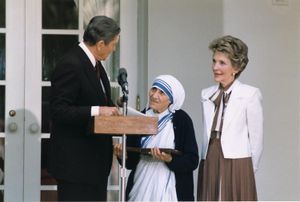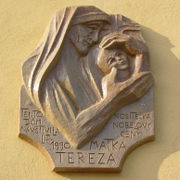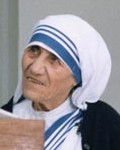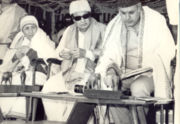Mother Teresa
2007 Schools Wikipedia Selection. Related subjects: Religious figures and leaders
Mother Teresa (born Agnes Gonxha Bojaxhiu ( August 26, 1910 – September 5, 1997), Bharat Ratna, OM, was an Albanian Roman Catholic nun who founded the Missionaries of Charity in India. Her work among the poverty-stricken in Kolkata (Calcutta) made her one of the world's most famous people, and she was beatified by Pope John Paul II in October 2003. Hence, she may be properly called Blessed Teresa by Catholics.
Born in Skopje, Ottoman Empire (located in modern-day Macedonia), at 18 she left home to join the Sisters of Loretto. In 1962, she received the Magsaysay Award for Peace and International Understanding. In 1971, she was awarded the Pope John XXIII Peace Prize. Teresa was also awarded the Templeton Prize in 1973, the Nobel Peace Prize in 1979, and India's highest civilian award, the Bharat Ratna, in 1980. She was awarded the Legion d'Honneur from Jean-Claude Duvalier in 1981. She was presented with the Presidential Medal of Freedom in 1985, was made an Honorary Citizen of the United States (one of only two people to have this honour during their lifetime) in 1996, and received the Congressional Gold Medal in 1997. She was the first and only person to be featured on an Indian postage stamp while still alive.
While her supporters sometimes referred to her as the "Angel of Mercy" and "Saint of the Gutter," critics have raised questions about her public statements, working practices, political connections, and the use of funds donated to her charity.
Early years in Skopje
Gonxhe was born in the centre of Skopje on 27 August 1910 to Albanians Nikollë and Dranafille Bojaxhiu, both originally from Kosovo. She became a member of the Loreto Order of nuns when she was 17.
The Beginnings of the Missionaries of Charity
In October, 1950 Teresa received Vatican permission to start a diocesan congregation, which would become the Missionaries of Charity, whose mission was to care for (in her own words) "the hungry, the naked, the homeless, the crippled, the blind, the lepers, all those people who feel unwanted, unloved, uncared for throughout society, people that have become a burden to the society and are shunned by everyone." It began as a small order with 12 members in Calcutta; today it has more than 4,000 nuns running orphanages, AIDS hospices, and charity centers worldwide, and caring for refugees, the blind, disabled, aged, alcoholics, the poor and homeless and victims of floods, epidemics and famine on all six continents.
In 1952 the first Home for the Dying was opened in space made available by the City of Calcutta. With the help of Indian officials she converted an abandoned Hindu temple into the Kalighat Home for the Dying, a free hospice for the poor. She renamed Kalighat, the Home of the Pure Heart (Nirmal Hriday). She soon opened a home for those suffering Hansen's disease, commonly known as leprosy, and called it Shanti Nagar (City of Peace). An orphanage followed. The order soon began to attract both recruits and charitable donations, and by the 1960s had opened hospices, orphanages and leper houses all over India. She was one of the first to establish homes for AIDS victims.
Teresa's order started to rapidly grow, with new homes opening all over the globe. The order's first house outside India was in Venezuela, and others followed in Rome and Tanzania, and eventually in many countries in Asia, Africa, and Europe, including Albania.
By the early 1970s, Mother Teresa had become an international celebrity. Her fame can be in large part attributed to the 1969 documentary Something Beautiful for God which was filmed by Malcolm Muggeridge and his 1971 book of the same title, which is still in print. During the filming of the documentary, footage taken in poor lighting conditions, particularly the Home for the Dying, was thought unlikely to be of usable quality by the crew. After returning from India, however, the footage was found to be extremely well-lit. Muggeridge claimed this was a miracle of "divine light" from Mother Teresa herself. Others in the crew thought it more likely ascribable to a new type of Kodak film. Muggeridge later converted to Catholicism.

In 1971 Paul VI awarded her the first Pope John XXIII Peace Prize. Other awards bestowed upon her included a Kennedy Prize (1971), the Balzan prize (1978) for humanity, peace and brotherhood among peoples, the Albert Schweitzer International Prize (1975), the United States Presidential Medal of Freedom (1985) and the Congressional Gold Medal (1994), honorary citizenship of the United States ( November 16, 1996), and honorary degrees from a number of universities. In 1972 Mother Teresa was awarded the Nehru Prize for her promotion of international peace and understanding.
In 1979, Mother Teresa was awarded the Nobel Peace Prize, "for work undertaken in the struggle to overcome poverty and distress, which also constitute a threat to peace." She refused the conventional ceremonial banquet given to laureates, and asked that the $6,000 funds be diverted to the poor in Calcutta, claiming the money would permit her to feed hundreds of needy for a year. She is stated to have said that earthly rewards were important only if they helped her help the world’s needy. When Mother Teresa received the prize, she was asked, "What can we do to promote world peace?" Her answer was simple: "Go home and love your family." In the same year, she was also awarded the Balzan Prize for promoting peace and brotherhood among the nations.
In 1982, Mother Teresa persuaded Israelis and Palestinians, who were in the midst of a skirmish, to cease fire long enough to rescue 37 mentally handicapped patients from a besieged hospital in Beirut.
When the walls of Eastern Europe collapsed, she expanded her efforts to communist countries that had rejected her, embarking on dozens of projects. She was undeterred by criticism about her firm stand against abortion and divorce saying, "No matter who says what, you should accept it with a smile and do your own work."
Mother Teresa travelled to help the hungry in Ethiopia, radiation victims at Chernobyl, and earthquake victims in Armenia.
In 1991, Mother Teresa returned for the first time to her native region and opened a Missionaries of Charity Brothers home in Tirana, Albania.
By 1996, she was operating 517 missions in more than 100 countries. Over the years, Mother Teresa’s Missionaries of Charity grew from 12 to thousands serving the "poorest of the poor" in 450 centers around the world. The first Missionaries of Charity home in the United States was established in the South Bronx, New York.
Deteriorating health and death
In 1983 Teresa suffered a heart attack in Rome, while visiting Pope John Paul II. After a second attack in 1989, she received a pacemaker. In 1991, after a battle with pneumonia while in Mexico, she had further heart problems.
She offered to resign her position as head of the order. A secret ballot vote was carried out, and all the nuns, except herself, voted for Mother Teresa to stay. Mother Teresa agreed to continue her work as head of the Missionaries of Charity.
In April 1996, Mother Teresa fell and broke her collar bone. Later that year, in August, she suffered from malaria, and failure of the left heart ventricle. She underwent heart surgery, but it was clear that her health was declining. On March 13, 1997 she stepped down from the head of Missionaries of Charity and died on September 5, 1997, just 9 days after her 87th birthday.
The Archbishop of Calcutta, Henry Sebastian D'Souza, said he ordered a priest to perform an exorcism on Mother Teresa shortly before she died because he thought she was being attacked by a devil.
At the time of her death, Mother Teresa's Missionaries of Charity had over 4,000 sisters, an associated brotherhood of 300 members, and over 100,000 lay volunteers, operating 610 missions in 123 countries. These included hospices and homes for people with HIV/AIDS, leprosy and tuberculosis, soup kitchens, children's and family counseling programs, orphanages, and schools.
Mother Teresa was granted a full state funeral by the Indian Government, an honour normally given to presidents and prime ministers, in gratitude for her services to the poor of all religions in India. Her death was widely considered a great tragedy within both secular and religious communities. The former U.N. Secretary-General Javier Pérez de Cuéllar, for example, said: "She is the United Nations. She is peace in the world." Nawaz Sharif, the Prime Minister of Pakistan said that Mother Teresa was "A rare and unique individual who lived long for higher purposes. Her life-long devotion to the care of the poor, the sick, and the disadvantaged was one of the highest examples of service to our humanity."
Influence in the World
Mother Teresa's work inspired other Catholics to affiliate themselves with her order. The Missionaries of Charity Brothers was founded in 1963, and a contemplative branch of the Sisters followed in 1976. Lay Catholics and non-Catholics were enrolled in the Co-Workers of Mother Teresa, the Sick and Suffering Co-Workers, and the Lay Missionaries of Charity. In answer to the requests of many priests, in 1981 Mother Teresa also began the Corpus Christi Movement for Priests. Today over one million workers worldwide volunteer for the Missionaries of Charity.
During her lifetime and after her death, Mother Teresa was consistently found by Gallup to be the single most widely admired person, and in 1999 was ranked as the "most admired person of the 20th century." Notably, Mother Teresa out-polled all other volunteered answers by a wide margin, and was in first place in all major demographic categories except the very young.
Miracle and beatification
Following Teresa's death in 1997, the Holy See began the process of beatification, the second step towards possible canonization, or sainthood. This process requires the documentation of a miracle performed from the intercession of Mother Teresa. In 2002, the Vatican recognized as a miracle the healing of a tumor in the abdomen of an Indian woman, Monica Besra, following the application of a locket containing Teresa's picture. Monica Besra said that a beam of light emanated from the picture, curing the cancerous tumor.
The issue of the alleged miracle proved controversial in India around the time of Mother Teresa's beatification. Teresa was formally beatified by Pope John Paul II on October 19, 2003 with the title Blessed Teresa of Calcutta. A second miracle is required for her to proceed to canonization.
According to The Daily Telegraph, Besra's husband initially said that the tumor was cured by medical treatment. He is quoted as saying: "This miracle is a hoax. It is much ado about nothing. My wife was cured by the doctors." He later changed his mind, however, and told an interviewer: "It was her miracle healing that cured my wife. Our situation was terrible and we didn't know what to do. Now my children are being educated with the help of the nuns and I have been able to buy a small piece of land. Everything has changed for the better." According to Monica Besra in TIME Asia, records of her treatment were removed by a member of the order from the hospital and are now with a nun.
Controversy and critics
Critics of Mother Teresa have argued that her organization provided substandard care, and were primarily interested in converting the dying to Catholicism. At the same time, Teresa received large sums in donations, the amount or destination of which has not been revealed. These donations are alleged to have been transferred to Catholic missionary programs elsewhere, rather than being spent on improving the standard of healthcare. Furthermore, Teresa's relationships with some donors and political figures has been a source of controversy. The Catholic Church has dismissed most of these criticisms.
Destination of donations
Christopher Hitchens, a British journalist now living in Washington, D.C., described Mother Teresa's organization as a cult which promoted suffering and did not help those in need. Hitchens wrote that Mother Teresa's own words on poverty proved that "her intention was not to help people." He quoted Mother Teresa's words at a 1981 press conference in which she was asked: "Do you teach the poor to endure their lot?" She replied: "I think it is very beautiful for the poor to accept their lot, to share it with the passion of Christ. I think the world is being much helped by the suffering of the poor people."
Hitchens further alleged that Mother Teresa lied to donors about what their contributions were to be used for. Donors were told that the money went to aid and the construction of healthcare facilities in India and elsewhere. Evidence points to it instead being spent largely on missionary work and that Mother Teresa was actually the controller of some of the funds. No hospitals were ever built. In 1994, Hitchens published an article in The Nation entitled "The Ghoul of Calcutta".
Dr. Aroup Chatterjee, the author of "Mother Teresa: The Final Verdict" (2003), asserted that the public image of Mother Teresa as a helper of the poor, the sick, and the dying was misleading and overstated; the number of people who are served by even the largest of the homes is not nearly as large as westerners are led to believe.
Hitchens, with British journalist Tariq Ali, co-produced a television documentary for the UK's Channel 4 called Hell's Angel, which was based on Aroup Chatterjee's work. Although he has never disputed the documentary's conclusions, Chatterjee criticized what he called the "sensationalist" approach of the film . The next year Hitchens published The Missionary Position: Mother Teresa in Theory and Practice, which contained much of the same content, though with more references.
Criticism of care provided
In 1991, Dr. Robin Fox, then editor of the British medical journal The Lancet, visited the Home for Dying Destitute in Calcutta and described the medical care the patients received as "haphazard". He observed that sisters and volunteers, some of whom had no medical knowledge, had to make decisions about patient care, because of the lack of doctors in the hospice. Dr. Fox specifically held Teresa responsible for conditions in this home, and observed that her order did not distinguish between curable and incurable patients; people who could otherwise survive their ordeals would be at a heightened risk of dying from infections and lack of treatment.
Fox conceded that the regimen he observed included cleanliness, the tending of wounds and sores, and kindness, but he noted that the sisters' approach to managing pain was "disturbingly lacking". The formulary at the facility Fox visited lacked strong analgesics which he felt clearly separated Mother Teresa's approach from the hospice movement. Fox also wrote that needles were rinsed with warm water, which left them inadequately sterilized, and the facility did not isolate patients with tuberculosis.
Aroup Chatterjee alleged that many operations of the order engage in absolutely no charitable activity at all, but instead use their funds for missionary work. He stated, that none of the eight facilities that the Missionaries of Charity run in Papua New Guinea have residents living there; their sole use is converting people to Catholicism. In an open letter to Mother Teresa Chatterjee asked for clarification. In the letter, he quotes her as having given numbers of 57,000 helped at a single facility, 250,000 helped at another, thousands helped daily at another. He cast doubt upon these numbers.
Chatterjee contends that families of the residents of its homes were not allowed to visit their loved ones and that, among India's charitable organizations, Mother Teresa's Missionaries of Charity is the only one which refuses to release a public financial account.
There have been a series of other reports documenting inattention to medical care in the order's facilities. Similar points of view have also been expressed by some former volunteers who worked for Teresa's order.
Attitude toward political leaders
Mother Teresa made some public statements regarding political leaders that have produced controversy. After Indian Prime Minister Indira Gandhi's suspension of civil liberties in 1975, Mother Teresa said: "People are happier. There are more jobs. There are no strikes." These approving comments were seen as a result of the friendship between Teresa and the Congress Party. These comments were criticized even in Catholic media. (Chatterjee, p. 276). In 1981, she made a trip to Haiti to accept an honour from Jean-Claude Duvalier, who was notorious as a repressive kleptocrat, and praised the Duvalier family as friends of Haiti's poor. In 1989, she travelled to Albania and laid a wreath at the grave of Enver Hoxha, the nation's hard-line Stalinist leader throughout the Cold War era, who had outlawed religion and sometimes brutally repressed religious expressions, including those of the Catholic Church.
Another example of Teresa apparently abandoning her convictions where the famous and powerful were involved concerns the subject of divorce. Hitchens wrote that in spite of her hostility to the practice, she nevertheless told the Ladies Home Journal that, with respect to the marriage of Prince Charles and Princess Diana, "It is a good thing that it is over. Nobody was happy anyhow." The question of whether or not she personally felt that divorce for all should be allowed among Catholics was not raised, but rather was left for the Pope, in his role as Holy Father of the Catholic Church, to discern.
The Tamil Nadu Government headed by the Late Dr.M.G.Ramachandran established a women's university in Kodaikanal named after Mother Teresa.
Baptisms of the dying
Mother Teresa has garnered criticism for her encouragement of sacramental baptisms being performed on the dying (a majority of which were Hindus and Muslims), thus converting them to the Catholic faith. These were done without regard to the individuals' religion. In a speech at the Scripps Clinic in San Diego, California in January, 1992, she said, "Something very beautiful... not one has died without receiving the special ticket for St. Peter, as we call it. We call baptism 'a ticket for St. Peter.' We ask the person, do you want a blessing by which your sins will be forgiven and you receive God? They have never refused. So 29,000 have died in that one house [in Kalighat] from the time we began in 1952."
The Catholic Church's response to criticism
In the process of examining Teresa's suitability for beatification and canonization, the Roman Curia (the Vatican) pored over a great deal of documentation of published and unpublished criticisms against her life and work. Vatican officials say Hitchens' allegations have been investigated by the agency charged with such matters, the Congregation for the Causes of Saints, and they found no obstacle to Mother Teresa's canonization. Due to the attacks she has received, some Catholic writers have called her a sign of contradiction.
Commemoration

Memorial Museum of Mother Theresa
A memorial room (museum) was opened in the Feudal Tower in Skopje, a building in which she used to play as a child. The museum has a significant selection of objects from Mother Theresa’s life in Skopje and relics from her later life. In the Memorial room there is a model of her family home, made by the artist Vojo Georgievski.
Next to the Memorial room, there is an area with the image of Mother Theresa and her prayer as well as a memorial park and a fountain.
Memorial plaque where Mother Theresa’s home stood
Just at the edge of Skopje’s city mall is the place where the house of Mother Theresa used to stand. The memorial plaque was dedicated in March of 1998 and it reads: “On this place was the house where Gondza Bojadziu - Mother Theresa - was born on 26 August 1910”. Her message to the world is also inscribed: “The world is not hungry for bread, but for love”
Mother Teresa Day in Albania
Mother Teresa Day (Dita e Nënë Terezës) on October 19 is a public holiday in Albania.
Mother Teresa in Kosovo
The main street in Kosovo`s capital Pristina is called Mother Theresa Street (Rruga Nëna Terezë)

